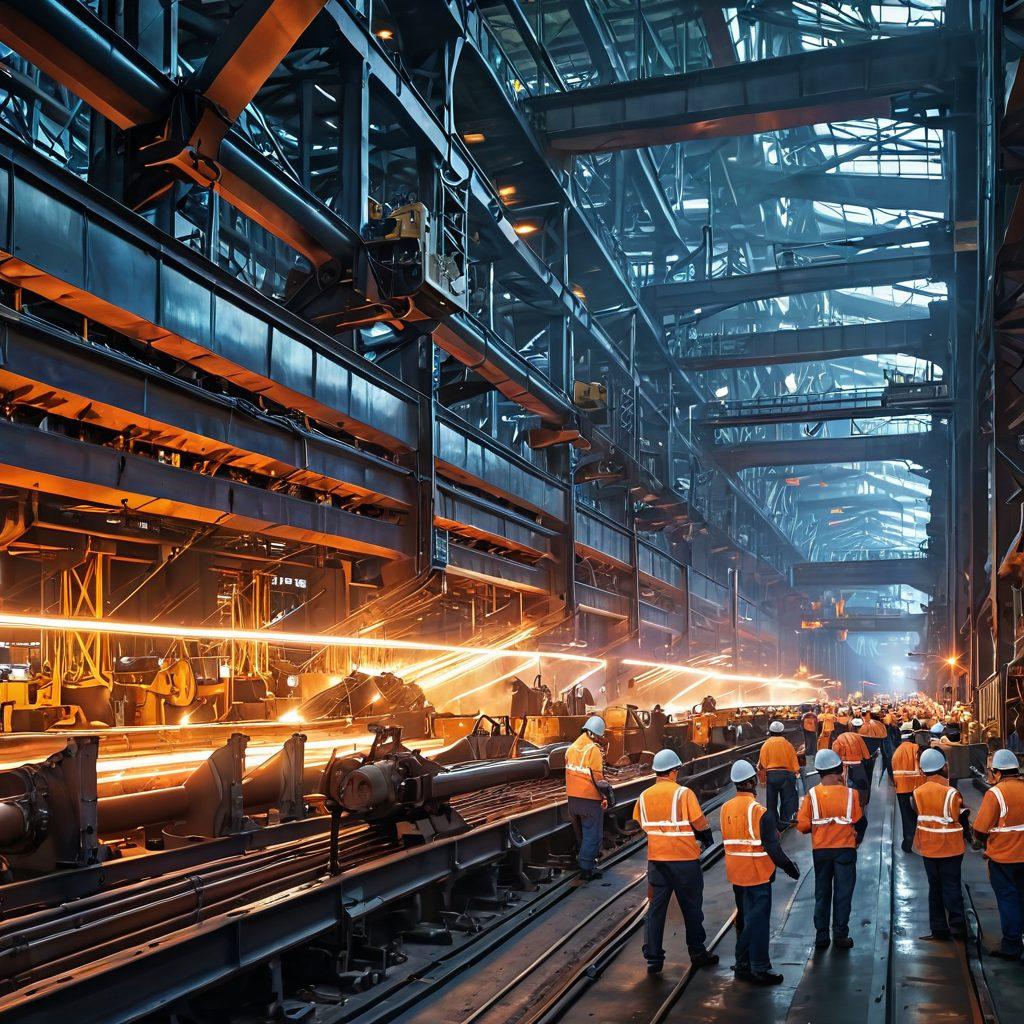Navigating the Steel Supply Chain: Insights, Trends, and Pricing in the Metal Industry
In the ever-evolving world of metal resources, navigating the steel supply chain can sometimes feel like threading a needle in the dark. Have you ever wondered what truly drives the dynamics of the steel industry? Understanding the key trends and insights can help you make more informed decisions, whether you're a supplier, a manufacturer, or someone keen on keeping up with the latest steel news. From the intricacies of steel pricing to the critical elements of steel procurement, the steel supply chain weaves a complex yet fascinating tapestry of innovation and resilience.
Picture this: a busy warehouse bustling with activity, trucks loading up steel for construction projects while others unload fresh coils of ferrous metals. This bustling scenario encapsulates the pulse of the steel distribution network. At the heart of it, lies the steel inventory management—a critical aspect that can determine the success or failure of a project. With steel trends fluctuating, staying on top of the right inventory levels ensures that you meet demands without falling victim to price hikes or supply shortages. It’s a dance of balance, and those who master it often find themselves ahead of the curve in the competitive steel wholesale market.
But what about the forces shaping this market? A litany of factors from global demand, technological innovations, and even environmental regulations play an essential role in the metal trade landscape. For example, steel manufacturing is continuously evolving with sustainable practices becoming the norm. How does your business adapt to these shifts? A commitment to sustainable practices not only enhances credibility but also aligns with the increasing global emphasis on responsible sourcing. Whether you’re involved in steel construction or steel fabrication, integrating sustainability could be the strategic edge your company needs.
As we dive deeper into steel market analysis, it’s evident that understanding the dynamics of the steel supply chain is not just about crunching numbers. It’s about comprehending the broader context of metal supply chain economics. Are trade policies impacting the availability of ferrous supply? How do shifts in production rates affect steel insight on regional markets? Asking these questions will not only heighten your awareness of market trends but will also enable you to engage more thoughtfully in discussions around metal analysis and dynamics.
So, how can you prepare for the future of the steel industry? Engaging in continuous research and networking with key players in the field, while leveraging technology for better forecasting models will equip you for whatever challenges lie ahead. Participating in metallurgy blogs, webinars, and industry forums will further sharpen your insights into the intricate world of industrial metals. As you navigate this lively field, remember: the strength of your steel supply chain is directly tied to your willingness to adapt and learn. After all, the journey through the steel supply chain is not just about moving metal; it's about shaping the future.
Pricing Strategies and Market Analysis in the Evolving Metal Landscape
In the ever-evolving landscape of the metal industry, understanding pricing strategies and market analysis has become essential for all stakeholders. The realm of steel and ferrous metals is filled with fluctuations that require keen insights and a grasp on current trends. Have you ever wondered how global events impact the cost of steel and other industrial metals? Whether you’re a seasoned supplier or a newcomer, staying updated with the latest steel news is crucial. This post dives deep into the pricing strategies and market dynamics that shape the future of the steel supply chain.
When we talk about steel pricing, it's important to consider various factors that contribute to the pricing strategies employed by suppliers and manufacturers. From market demand and raw material costs to geopolitics and trade regulations, the complexity of steel sourcing can feel overwhelming. Steel distribution, after all, is not simply about getting materials from point A to point B; it encompasses a broader spectrum of negotiations, contracts, and relationships. What strategies could you adopt to navigate these influences effectively? Developing an adaptable approach can help any business manage unexpected changes in steel inventory and supply.
Consider the impact of steel trends on your procurement decisions. If you've followed recent metal resources, you may have noticed the rise in demand for sustainable and recycled materials. In today's world, the notion of 'green steel' is gaining momentum, attracting attention from both businesses and consumers. Are you prepared to capitalize on this trend in your steel fabrication or construction projects? Embracing sustainability may not only help reduce costs but also present new marketing opportunities in an increasingly eco-conscious marketplace.
Engaging in metal trade discussions often leads to questions about market analysis and the best practices for securing materials. Steel market analysis can provide valuable insights into which suppliers are best positioned for price stability and reliability. Armed with steel industry updates, you can become a strategic player in negotiating the best deals. What if implementing a robust approach to monitoring steel supply chains could give you that edge in your procurement conversations? With the right knowledge, the possibilities for your business are virtually endless.
As we reflect on the ever-changing nature of the metal supply chain, remember that knowledge is your greatest ally. The intricacies of steel manufacturing and the dynamics of ferrous supply manage the pace and flow of the market. By staying attuned to steel insights and metal analysis, you empower yourself to make informed decisions that drive growth and efficiency. So, what will be your next move in this vibrant world of industrial metals? The future of your steel supply strategy begins with a single question: how can you adapt and thrive in these challenging conditions?
A Comprehensive Guide to Steel Sourcing, Distribution, and Inventory Management
Navigating the world of steel sourcing, distribution, and inventory management can feel like traversing a labyrinthine market landscape. With steel prices fluctuating, and steel trends continuously evolving, how can one make sense of it all? As industries lean into the power of ferrous metals, understanding the steel supply chain becomes not just beneficial, but essential. Let’s dive deeper into the complex and dynamic realm of metal supply and discover actionable insights for effectively managing steel resources.
Picture this: You’re an operations manager responsible for sourcing steel for your company’s latest construction project. You start your day by scanning the latest steel news and metal news to identify trends and predict future pricing. You find yourself asking, 'Is this the right time to buy?' Timing your purchases can lead to significant cost savings or, conversely, unnecessary expenses. By understanding steel pricing and monitoring steel industry updates, you can make informed decisions that benefit your bottom line.
However, the road to successful steel procurement is not merely about seizing favorable prices. It also involves establishing strong relationships in metal trade and understanding different layers of steel distribution. Imagine being able to navigate the complexities of steel wholesale while forging valuable partnerships that promise not only efficiency but reliability. Ask yourself: Who are your suppliers, and how well do you know them? Solid connections in the metal supply chain can mean the difference between success and delays, especially in the fast-paced construction and manufacturing sectors.
As we delve into the intricacies of steel inventory management, it’s vital to reflect on the key factors influencing stock levels—everything from forecasting steel demand to evaluating production capabilities. A well-structured approach to steel inventory can empower businesses to respond swiftly to market fluctuations, a necessity in today’s volatile environment. The question is: how prepared is your operation for unforeseen changes in the metals market? Investing time in robust inventory management strategies will undoubtedly pay off, especially during critical moments like singular steel shortages or spikes in demand.
Ultimately, the journey through the metal supply chain can be both enlightening and rewarding. Regularly engaging with a metallurgy blog or subscribing to steel market analysis newsletters can equip you with the insights you need. Analyze trends, follow news, and share experiences with others in the industry. Remember, it’s not just about sourcing steel; it's about crafting a strategy that weaves together steel sourcing, distribution, and inventory management as part of a cohesive operation—an operation that's ready to tackle the challenges of tomorrow's steel market head-on.


